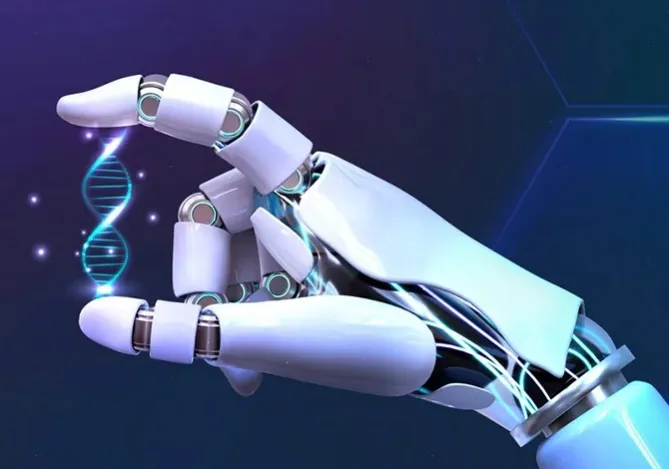
Source Image: ClaudeAI.uk
In 2020, the University of Vermont built the first living robots, Xenobots. These living robots synthesised from frog cells were discovered to have the capacity to ‘rebuild’ or ‘reproduce’ other Xenobots. This discovery was quintessential in the future of AI and regenerative medicine. The synergy between artificial intelligence (AI) and biotechnology holds immense potential to reshape various facets of healthcare, drug discovery, and biotechnology research.
The potential for regenerative medication can be directly linked to synthetic biology in bioprocess optimisation, which can incorporate real-time monitoring and control of variables, waste reduction, and improved production efficiency, resulting in reduced drug pricing.
AI’s potential to analyse datasets and expedite screening processes can help increase speed times and accuracies for all these areas.
Integrating AI and biotechnology in drug discovery encompasses multifaceted dimensions, which are crucial to explore. These include drug target identification, screening, design and clinical trial optimisation. AI’s potential to analyse datasets and expedite screening processes can help increase speed times and accuracies for all these areas. Further, AI-powered computational models can facilitate the design of novel drug molecules and predict their properties.
AI in healthcare can also enhance personalised medicine through genomic analysis, using genetic data and biological markers to predict disease susceptibility and recommend interventions, drug development and consumption. Additionally, AI can also be used to aid in health record analysis to predict disease outcomes and susceptibilities in larger populations.
While there are many advantages to incorporating AI with biotechnology, there are also aligned concerns. Using AI to make predictions about disease vulnerability is a potential space for discriminatory practices that may enhance racial and caste-based biases that already exist in AI and are yet to be addressed by AI ethical guidelines effectively. Further concerns around AI-biotechnology integration also cover the unregulated development of biological agents and malicious use. A Massachusetts Institute of Technology (MIT) report highlighted the problems of AI or Large Language Models (LLMs) Chatbots assisting non-scientists and non-authorities in developing biological weapons.
AI can also be used to aid in health record analysis to predict disease outcomes and susceptibilities in larger populations.
With the potential for regenerative AI biotechnology and medicine, as seen with the Xenobots and the concurrent growth of AI in biotechnology development and research, this concern can be expanded to self-replicating bots that may have dual-use applications. With the potential of biotechnology escaping human control through self-replication and the possibility of biological weapon development being accessible by non-scientists, it becomes further imperative to address challenges and create compliance measures with innovation, not after the impact of innovation.
Regulatory compliance and global alliance
Despite the potential for revolutionary progress, integrating AI and biotechnology is challenging. These encompass data privacy concerns, the imperative need for high-quality datasets that disallow discriminatory practices, and regulatory complexities that allow for innovation but prevent misuse.
The rapid evolution of technologies, particularly the convergence of gene editing and machine learning, has far-reaching implications beyond their immediate applications. This synergy introduces new sectors and technological platforms and often occurs in a regulatory void. Despite the remarkable breakthroughs resulting from this convergence, there needs to be more effective oversight.
For example, the United States (US) has released a document on goals for biotechnology in research and development as of September 2022. Similarly, India has a draft biotechnology strategy till 2025. The European Union (EU) also has a collective of policies that govern biotechnology products. However, these mainly oversee investment and research in this area. Japan mentions the Cartagena protocol[1] in their list of regulations; however, it does not explicitly mention AI. As shown in the cases above, none of the leading economies in modern and emerging technologies explicitly discuss the entanglement of AI and biotechnology. Thus, there is a need for proactive and forward-thinking policies to navigate this convergence. Primarily, each country needs to establish a biotechnology policy that not only governs the investment in this area but also establishes ethical guidelines on the use of public data, establishes purpose limitation to avoid non-authority development of biological agents and prevents the unethical disease prediction that may further divide populations.
India has a draft biotechnology strategy till 2025. The European Union (EU) also has a collective of policies that govern biotechnology products.
Global platforms, such as the United Kingdom (UK) AI Summit and Bletchley Declaration, which concluded in November 2023, mentioned a need for an AI Safety Initiative. However, AI-biotechnology integration also needs to be addressed. The emphasis is on policies that address potential risks and capitalise on the myriad opportunities presented by these rapidly advancing technologies. International collaboration is the next critical factor in future-proofing societies in the face of such a technological convergence. Effective governance requires a holistic understanding of the global landscape, stressing the need for collaborative efforts on the international stage, particularly in the realms of artificial intelligence (AI) and biotechnology.
Additionally, platforms that already incorporate gene editing databases or other forms of biotechnology can be enhanced to include developments on the cross sections of AI and biotechnology. These can consist of platforms like the Global Alliance for Genomic Health (GA4GH), which already addresses national initiatives and can be a platform used to discuss AI use in genetic editing as well.
In such a collaboration, the scientific community must promote collaboration and transparency. Active communication between economies and technologists, scientists and policymakers becomes vital in fostering an environment conducive to cooperation. Public dialogues that include non-technical audiences are also crucial, as evidenced by a discussion held by the University of Cambridge on embryo editing and making such a concept more approachable after the public dismissal of other forms of gene editing, like test-tube babies.
Conclusion
The synthesis of living robots, exemplified by the Xenobots created by the University of Vermont in 2020, marks a groundbreaking intersection of artificial intelligence (AI) and biotechnology. This innovation holds transformative potential across various domains, including regenerative medicine, drug discovery, and healthcare. As with any innovation, there are concerns about malicious dual-use, including discriminatory practices, the development of biological agents, and many other future uses that will be unveiled with growing technologies.
The synthesis of living robots, exemplified by the Xenobots created by the University of Vermont in 2020, marks a groundbreaking intersection of artificial intelligence (AI) and biotechnology.
While addressing aspects of biotechnology, the existing regulatory landscape often needs more explicit coverage of the entanglement of AI and biotechnology. Countries must establish biotechnology policies that govern the technology and its growth rather than just investing in these areas. This can further be enhanced by global collaboration.
As we stand on the precipice of a new era in science and technology, a harmonious collaboration between nations and stakeholders is imperative to unlock the full potential of AI and biotechnology while mitigating associated risks.
Shravishtha Ajaykumar is an Associate Fellow at the Observer Research Foundation
[1] Under the Convention of Biological Diversity. Engages modern technologies which may include AI.
The views expressed above belong to the author(s). ORF research and analyses now available on Telegram! Click here to access our curated content — blogs, longforms and interviews.




 PREV
PREV


